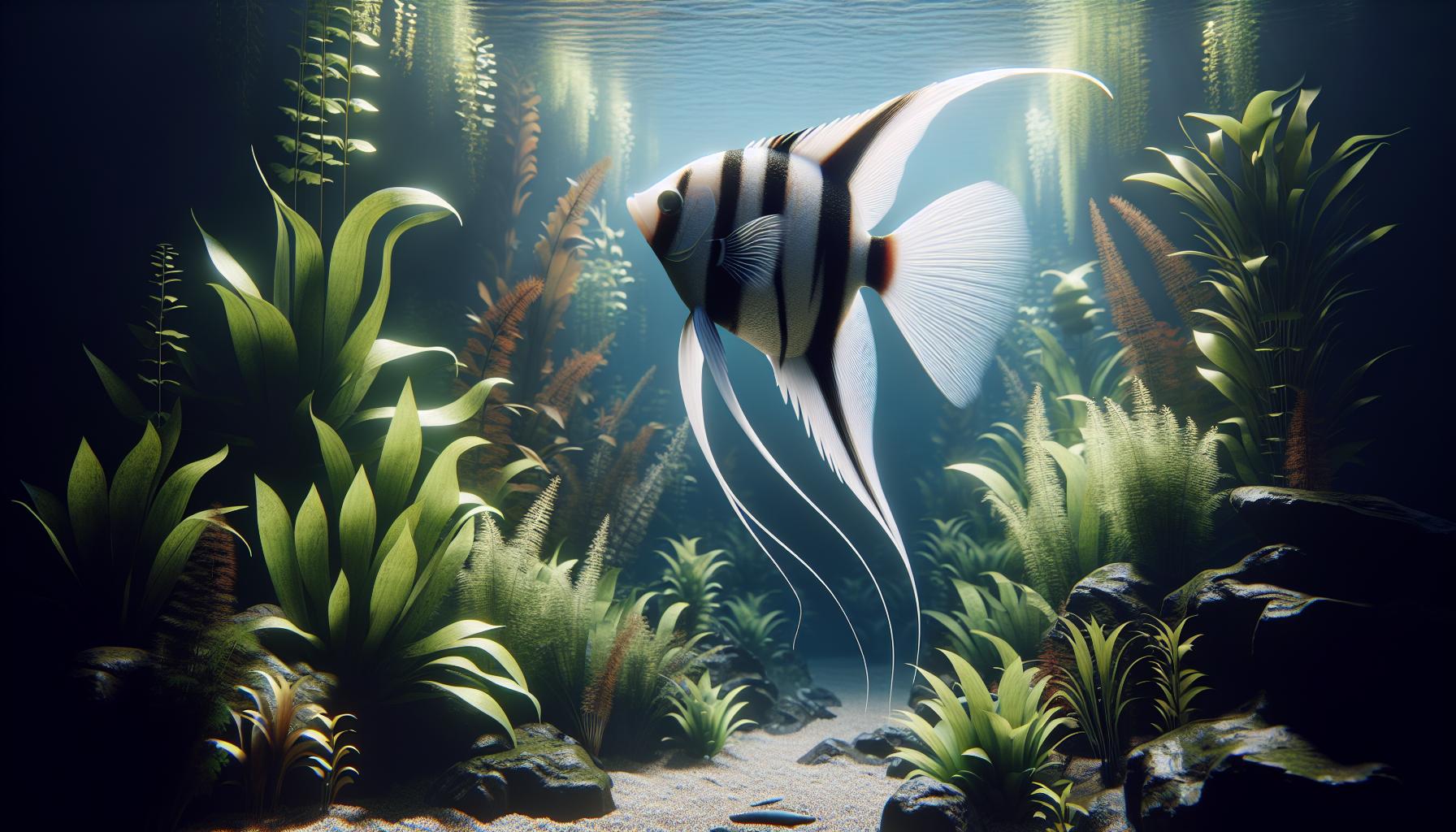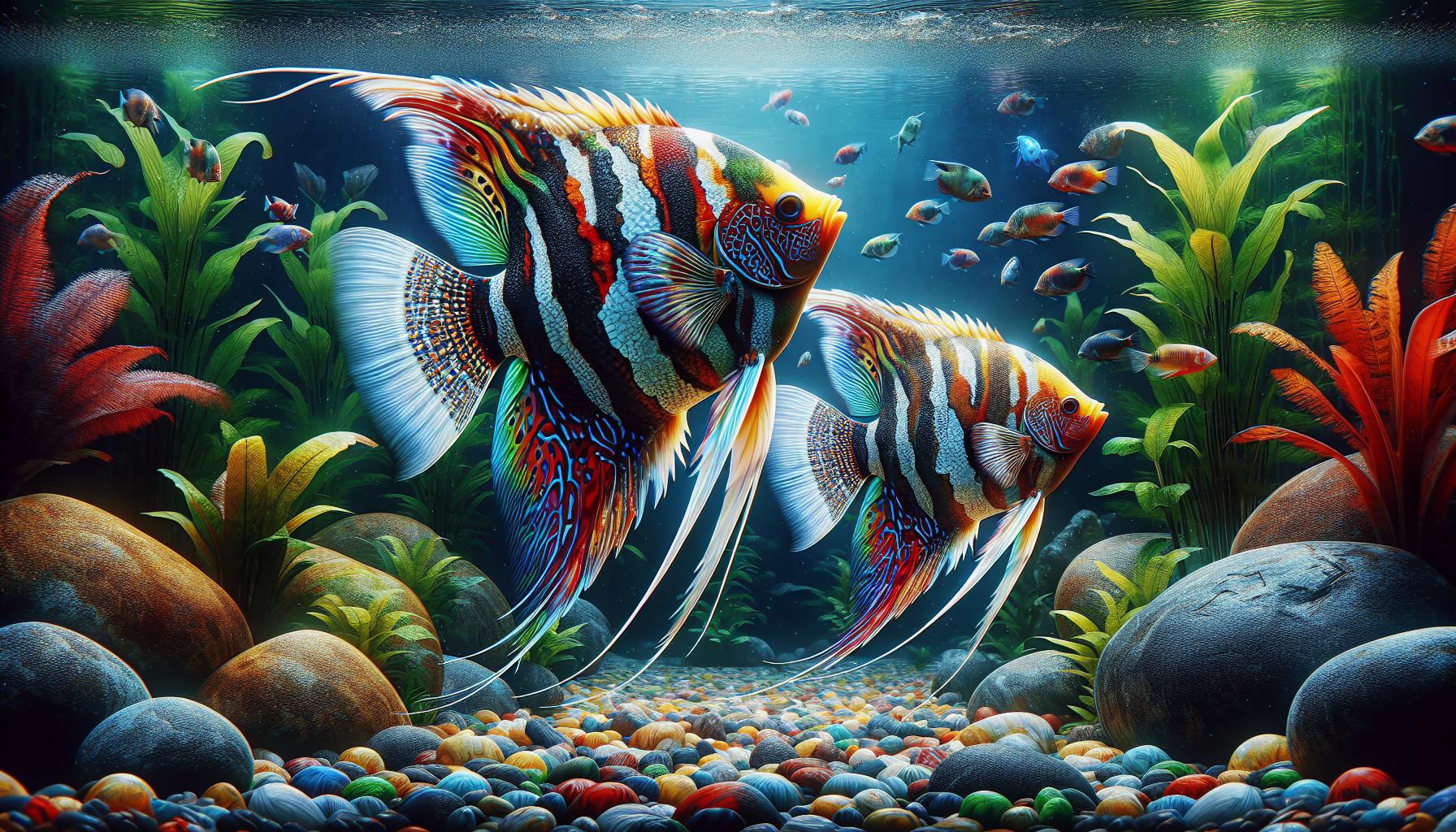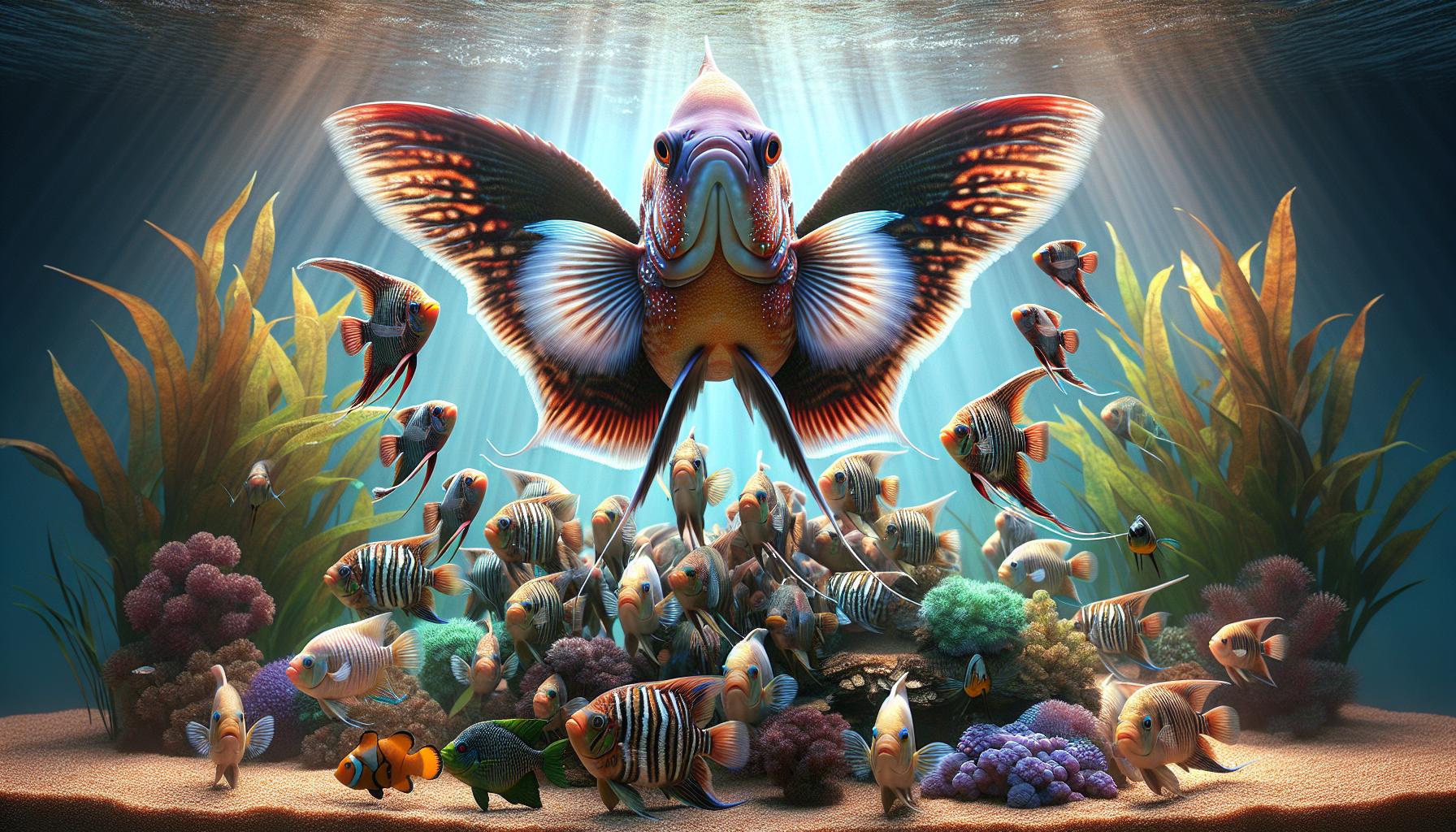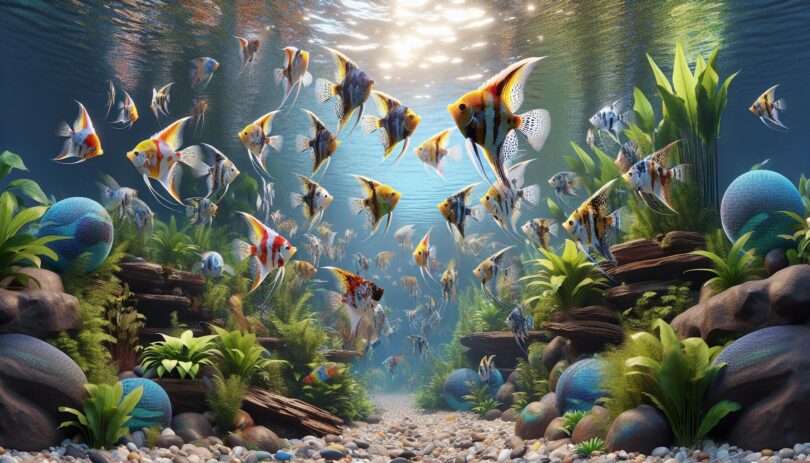Angelfish, with their majestic fins and vibrant colors, have captivated the hearts of aquarium enthusiasts around the world. I’ve always been fascinated by their graceful movements and the elegance they add to any aquatic setting. These stunning creatures are not just a feast for the eyes but are also known for their unique behavior and care requirements.
Diving into the world of angelfish, I’ve discovered that there’s so much more to these fish than meets the eye. Whether you’re a seasoned aquarist or just starting out, understanding the nuances of angelfish care can be both rewarding and challenging. Let’s embark on a journey to uncover the secrets of keeping angelfish thriving in your aquarium.
Key Takeaways
- Angelfish are known for their majestic fins and vibrant colors, captivating aquarium enthusiasts worldwide; they add elegance to any aquatic setting and come in varieties such as silver, marble, and koi.
- These fish require a balanced diet, thrive in slightly acidic to neutral pH water, and need a clean and stress-free environment with a minimum of 20 gallons tank size for a healthy living.
- Angelfish exhibit unique behaviors and social structures, including establishing a pecking order in community tanks and forming monogamous pairs for life, showcasing the complexity of their interactions.
- Proper angelfish care involves maintaining optimal water conditions (pH 6.8 – 7.8, temperature 76°F – 82°F), ensuring a varied diet, managing social dynamics, and providing ample space to reduce stress and aggression.
- Breeding angelfish can be rewarding yet requires patience, a keen eye for detail, and the provision of the right conditions for the pair to lay and care for their eggs.
- A successful angelfish tank is an art form that teaches patience and the importance of creating a balanced ecosystem, showcasing the dedication required to mimic their natural habitat and maintain their health.
Angelfish: The Majestic Beauties

In my journey as an aquarist, I’ve always been drawn to angelfish for their unparalleled beauty and grace. These fish, with their long, flowing fins and bold stripes, seem to glide through the water with a dignity that’s nothing short of mesmerizing. It’s not just their appearance that captivates me, but also their distinct personalities that add life to any aquarium.
Angelfish belong to the Cichlid family, a detail that surprises many given their peaceful demeanor compared to other members of their family known for aggression. This unique contrast has always fascinated me, revealing the complexity and diversity within aquatic life. Their towering fins and elegant movements do not just add visual appeal but also a sense of serenity to the tank.
One of the most captivating aspects of angelfish is their color variety. From the classic silver with black stripes to exotic varieties like koi or marble, there’s an angelfish to match every aquarist’s palette. I’ve found that these variations can become quite addictive; collecting different types becomes a hobby within the hobby.
| Angelfish Variety | Description |
|---|---|
| Silver | Silver body with three black stripes |
| Marble | Black and white marbled pattern |
| Koi | Orange and white, resembling koi fish |
Caring for these majestic beauties has its challenges, especially when it comes to their diet and tank conditions. Angelfish thrive in slightly acidic to neutral pH water, and require a balanced diet that includes both plant and animal matter. Keeping their environment clean and stress-free is crucial for their health and well-being. This balance of aesthetics and care complexity makes angelfish not just pets, but a true hobbyist’s delight.
Engaging with angelfish and understanding their needs has taught me not only about the intricacies of aquatic life but also patience and the importance of creating a balanced ecosystem. Their presence in my aquarium continues to remind me why I started this journey in the first place.
Exploring the World of Angelfish

Diving into the realm of angelfish, I’ve realized that these creatures are more than just a beautiful addition to any aquarium. They embody the intricate balance of nature and the artistry it can achieve under the right conditions. My journey began with a single pair, but soon, the diversity and complexity of these fishes hooked me, urging me to delve deeper.
Angelfish are known for their majestic fins and vibrant patterns, traits that set them apart in the aquatic world. However, what’s truly fascinating is their social structure and behavior. They exhibit a range of interactions that can be both endearing and, at times, challenging for aquarists. For example, angelfish pair for life, displaying loyalty and complex mating rituals that are a marvel to observe.
The care requirements for angelfish have taught me a lot about the delicate balance required in maintaining an aquarium. From water conditions to diet, everything needs to be just right. They thrive in warm, slightly acidic water with plenty of space to swim. Their diet is another area where attention to detail matters; angelfish benefit from a mix of high-quality flakes, live, and frozen foods, ensuring they receive the necessary nutrients.
| Parameter | Ideal Range |
|---|---|
| Water Temperature | 76°F – 84°F (24°C – 29°C) |
| pH Level | 6.5 – 7.5 |
| Tank Size | Minimum 20 gallons |
Breeding angelfish has been another aspect of my adventure. It’s not for the faint-hearted, requiring patience and a keen eye for detail. Ensuring the right conditions and watching the pair lay eggs, which then evolve from tiny dots into beautiful, free-swimming fry, is nothing short of magical.
In exploring the world of angelfish, I’ve not only expanded my understanding but have come to appreciate the dedication required to mimic their natural habitat. This journey has reinforced the idea that keeping angelfish isn’t just a hobby—it’s an art form that teaches us about the complexity of aquatic life and the patience required to sustain it.
Understanding Angelfish Behavior

When I first started diving into the world of angelfish, their behavior caught my attention as much as their stunning looks. These fish exhibit a range of behaviors that are both fascinating and, at times, challenging to understand. One of the most intriguing aspects is their social hierarchy. In a community tank, angelfish will establish a pecking order. This isn’t always evident at first, but watch them for a while, and you’ll notice some fish swimming more dominantly while others seem to follow.
Another behavior that’s key to angelfish care is their territory needs. Even though they’re often peaceful, angelfish are cichlids, meaning they have a natural instinct to claim and defend territory, especially during breeding. Providing ample space and hiding spots in your tank can mitigate potential aggression and stress among tank mates.
Breeding behavior is where you see a different side of angelfish. They form monogamous pairs, often for life, and their courtship rituals are a dance of subtle moves and gentle nudges. Once a pair has bonded, they select a breeding site, meticulously cleaning it before laying eggs. Watching this process has given me a deeper appreciation for the complexity of their interactions.
Feeding time also reveals a lot about angelfish behavior. They’re not mere passive feeders; observing them approach food with caution and intelligence, assessing before eating, demonstrates their adaptability and keen senses.
Angelfish behavior has taught me patience and the importance of observing before acting. Whether it’s adjusting tank conditions or simply enjoying their presence, understanding their behavior has improved my ability to care for them significantly. Each observation offers a clue into creating a healthier, more harmonious aquatic environment for these majestic creatures.
Care Requirements for Angelfish
When I embarked on my journey to maintain a thriving angelfish habitat, I quickly learned that understanding their care requirements is crucial. Creating an environment that closely mimics their natural habitat in the Amazon Basin is not just beneficial; it’s essential for their well-being.
First off, water quality is paramount. Angelfish thrive in water with a pH between 6.8 and 7.8 and a temperature range of 76 to 82°F. I’ve always been diligent about installing a reliable heater and frequently testing the water to maintain these levels. It’s also vital to perform regular water changes, about 20% bi-weekly, to keep the tank environment clean and stable.
Another critical factor is tank size. Despite their elegant appearance, angelfish require ample space to roam. A tank of at least 20 gallons is recommended for a pair, but if you’re like me and aim for a small community, a 55-gallon tank or larger becomes a necessity. Remember, a spacious tank not only gives them the freedom to explore but also helps in reducing stress among tank mates.
| Requirement | Ideal Range |
|---|---|
| pH | 6.8 – 7.8 |
| Temperature (°F) | 76 – 82 |
| Tank Size (Gallons) | 20+ for a pair; 55+ for a community |
Diet also plays a significant role in their care. I’ve found that a varied diet consisting of high-quality flakes, frozen, and live foods not only keeps them healthy but also enhances their colors. Feeding them twice a day in small amounts that they can consume within a few minutes prevents overfeeding and maintains water quality.
Lastly, it’s important to consider their social structure. While angelfish are generally peaceful, they can exhibit territorial behavior, especially during breeding. Providing plenty of hiding spaces with plants and decor can help in managing aggression and ensuring a harmonious tank environment.
Caring for angelfish has taught me the importance of patience and attention to detail. Each step, from maintaining water quality to ensuring a balanced diet, plays a crucial role in their health and happiness.
Tips for Keeping Angelfish Thriving in Your Aquarium
Keeping angelfish isn’t just about adding water and fish to a tank; it’s about creating an environment where they can flourish. Through my years of experience, I’ve gathered some foolproof tips that have helped my angelfish not just survive but thrive.
Optimal Water Parameters
First and foremost, water quality can’t be compromised. Angelfish require specific conditions to stay healthy. They thrive in water with a pH level of 6.8 to 7.8, and the temperature should be kept between 76°F to 84°F. I make it a point to check these parameters weekly using a reliable water testing kit. Keeping the water within these ranges mimics their natural habitat and promotes robust health.
Tank Size Matters
Don’t underestimate the importance of space. For angelfish, a tank that’s too small can lead to stress and aggression. A minimum of 20 gallons for a pair is essential, but if you plan on having a community or breeding them, you’ll need a larger tank. I’ve found that a 55-gallon tank provides ample space for angelfish to swim freely and exhibit their natural behaviors.
Balanced Diet
A varied diet is crucial for keeping angelfish healthy. They’re omnivores, and in my tank, I provide a mix of high-quality flake food, frozen, and live foods. Offering a diverse diet ensures they get all the necessary nutrients. I feed my angelfish twice a day, careful not to overfeed as excess food can pollute the tank.
Social Environment
Understanding the social dynamics of angelfish is vital. They can be both peaceful and territorial. When introducing new fish, I always observe their behavior closely. Creating a tank with plenty of hiding spots and plants helps mimic their natural environment and reduces stress. I’ve noted that a well-thought-out tank layout can prevent many social issues before they start.
By focusing on these key aspects, I’ve seen remarkable improvements in the health and happiness of my angelfish. Regular maintenance, careful observation, and a little patience go a long way in creating a thriving aquatic environment.
Conclusion
Angelfish truly stand out as a jewel in the aquarium world. Their elegance and variety have captivated me, just as they do for many enthusiasts. Navigating the complexities of their care—from ensuring the right tank conditions to understanding their unique social behaviors—has been a rewarding journey. It’s clear that success with angelfish isn’t just about meeting their physical needs but also about appreciating the intricate social tapestry they weave in their aquatic realms. By offering them a slice of their natural habitat, we not only enhance their well-being but also unlock the full spectacle of their grace and beauty. For anyone willing to invest the time and effort, angelfish can transform an aquarium into a mesmerizing underwater ballet. And that’s an experience I find truly enriching.
Frequently Asked Questions
What family do angelfish belong to?
Angelfish are part of the Cichlid family, known for their peaceful demeanor, which is quite surprising given the aggressive nature of many other members of this family.
Why are angelfish considered appealing for aquarium enthusiasts?
Angelfish are favored for their graceful movements and the elegance they add to aquatic settings, along with their diverse array of colors and patterns that captivate collectors.
What are the challenges of caring for angelfish?
Caring for angelfish involves maintaining specific water parameters, a balanced diet, and a suitable tank size to ensure their health and well-being, reflecting the complexity of their care requirements.
Can you describe the social behavior of angelfish?
Angelfish display fascinating social behaviors, including a defined social hierarchy, complex mating rituals, and territoriality, showcasing their intelligent and interactive nature.
What are the specific care requirements for angelfish?
To care for angelfish properly, it’s essential to mimic their natural habitat by maintaining optimal water quality, providing ample tank space, managing the diet effectively, and facilitating a compatible social structure.
How can you breed angelfish successfully?
Successful breeding of angelfish requires dedication to mimic their natural breeding conditions, including specific water parameters and a calm environment, to encourage their complex mating rituals.
What tips can help keep angelfish thriving in an aquarium?
Keeping angelfish thriving demands regular maintenance, careful observation, and patience. Optimal water parameters, an adequately sized tank, a balanced diet, and a conducive social setting are crucial for their well-being.

